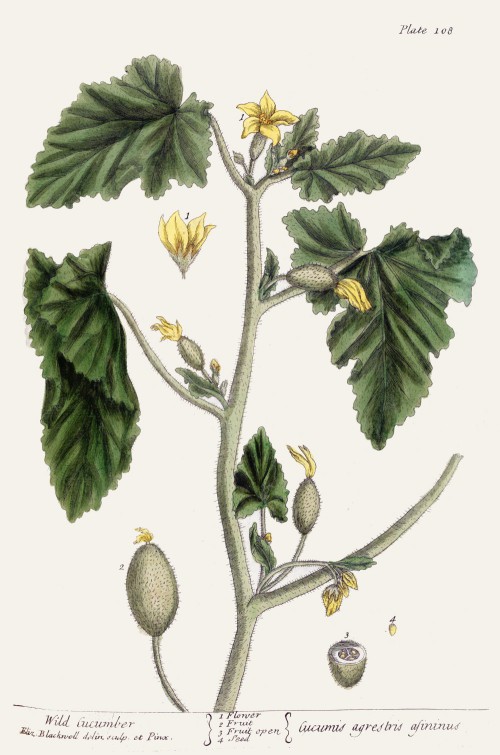Ecballium elaterium (L.) A. Rich. - syn. Momordica elaterium L. - Cucurbitaceae - squirting-cucumber, Spritzgurke
Prostrate plant, stem to 1.5m long, native to the Mediterranean, narturalized and cultivated elsewhere; leaves ovate-oblong or hastate, scabrous, abaxially white pubescent, adaxially white setose; male flowers in racemes; female flowers solitary, corolla yellow, ca. 3cm in diam.; fruit oblong or ovoid-oblong, up to 5cm long, scabrous, yellow-brown hispid, both ends obtuse; seeds ca. 4mm. http://www.efloras.org/florataxon.aspx?flora_id=2&taxon_id=200022624
„It gets its unusual name from the fact that, when ripe, it squirts a stream of mucilaginous liquid containing its seeds, which can be seen with the naked eye… This plant, and especially its fruit, is poisonous, containing cucurbitacins. In the ancient world it was considered to be an abortifacient.“ [Pliny Naturalis historia, Book XX,4] https://en.wikipedia.org/wiki/Ecballium_elaterium
„In Turkey, the fresh juice of this fruit has been used externally for the treatment of sinusitis. Dioscorides described that the application of powdered elaterium (precipitate from the fruit juice) mixed with milk into nostrils cleared away icterus and cured a headache of long continuance… This practice often causes severe congestion of the upper respirarory tract because of the high cytotoxicity of cucurbitacines contained in the fruit juice.“ Cucurbitacin B was shown to be the active anti-inflammatory constituent. The freeze-dried extract was administered orally (50-400mg/kg) in mice and showed strong inhibition of vascular permeability. The highest dosage of 400mg/kg was toxic, but 200mg/kg was powerful active against inflammation.
[Isolation of an anti-inflammatory principle from the fruit juice of Ecballium elaterium., Yesilada, E., Tanaka, S., Sezik, E., Tabata, M., Journal of natural products, 51(3), 1988, 504-508]
„… the structure of the active anti-inflammatory principle thus obtained is elucidated as cucurbitacin B. Further studies are conducted to evaluate the anti-inflammatory activity of cucurbitacin B using serotonin- and bradykinin-induced edemas in mice. On the other hand, cucurbitacin B content in the juice is determined as 2.48% by HPLC.“
[Research on the Turkish medicinal plant., Sezik, E., Chemistry of natural compounds 33(5), 1997, 541-542]

Blackwell,E., A curious herbal, vol.1 t.108 (1737)
http://plantgenera.org/species.php?id_species=367642